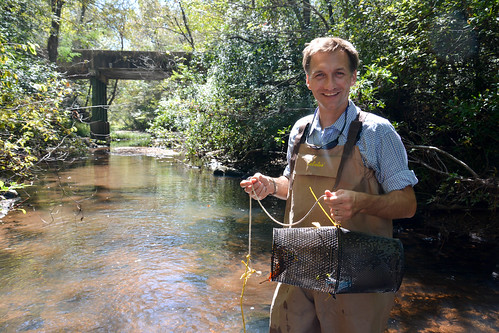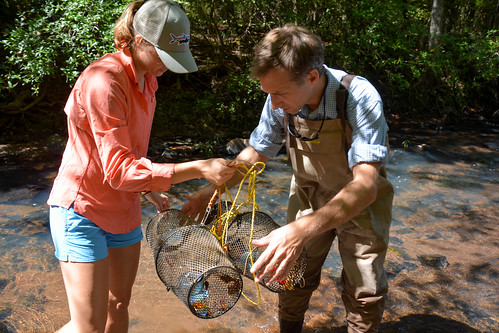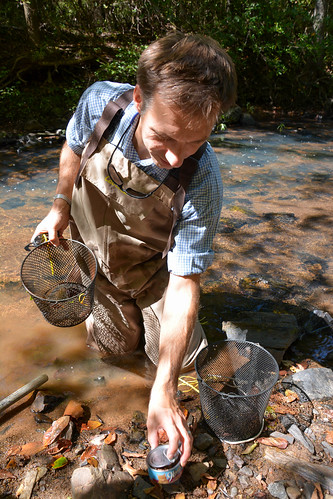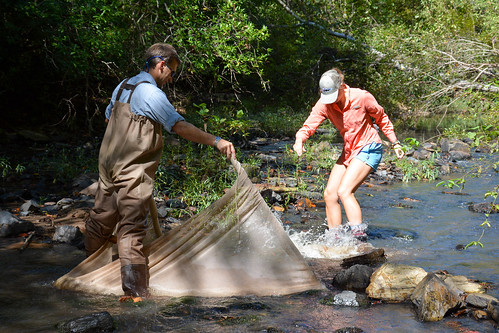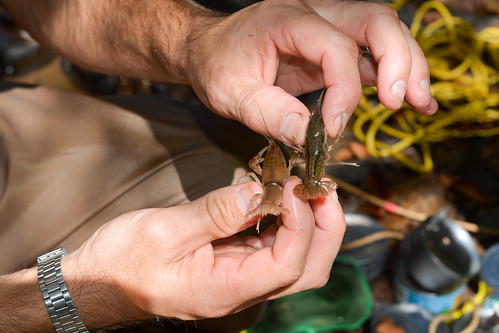COSAM News Articles 2016 February Crayfish collected in the Tallapoosa River Basin have a mysterious genetic heritage.
Crayfish collected in the Tallapoosa River Basin have a mysterious genetic heritage.
Crayfish, crawfish, crawdad, mudbug – for most people, these names refer to a delectable crustacean commonly served boiled. For two Auburn University scientists, a crayfish is an enigmatic creature with a genetic heritage that is as much mysterious as it is fascinating.
Biological Sciences Professor Scott Santos, along with Brian Helms, assistant research professor in the Department of Biological Sciences and Auburn University Museum of Natural History, recently completed a study on crayfish in the Tallapoosa River – not the kind of crayfish that are traditionally eaten, although Helms is quick to remind anyone that even tree bark can be eaten. The crayfish species studied by Santos and Helms, the Tallapoosa Crayfish and the Slackwater Crayfish, are species which are native to the Tallapoosa River, look almost identical, and are genetically related. The two species represent a mere snapshot of the enormous amount of aquatic biodiversity present in the Southeast, which includes some 347 recognized species and subspecies of crayfish.
“The Southeast is a global hot spot in terms of the diversity of these animals, and of all of the places in the Southeast, Alabama has the highest crayfish diversity with 86 species and several that have not yet been described,” said Helms.
With the help of Auburn University undergraduate student researchers, crayfish were collected from 30 locations within the upper, little, and middle Tallapoosa River. At each site, teams of scientists used dip-nets and kick seines to determine which crayfish species were present.
Once back in the lab, researchers worked diligently to preserve and separate Tallapoosa Crayfish specimens from Slackwater Crayfish specimens.
“Morphologically they are almost impossible to tell apart,” said Helms. “We had to have some additional experts come in and verify them because they are so difficult to discern.”
Visual differences between the Tallapoosa Crayfish and the Slackwater Crayfish include a slight variation in color, most notably in the species’ antennas; however, color differentiation isn’t always evident, especially since once crayfish are preserved, the color changes. The most evident physical differentiation is the second tail segment, or pleuron, which in the Tallapoosa Crayfish is angled and in the Slackwater Crayfish it is curved.
Helms noted that perhaps the most important difference between the two species is their preferred habitat: the Tallapoosa Crayfish seems to prefer gravel and cobbles in swift-flowing waters, whereas the Slackwater Crayfish is generally more common in undercut banks and rootwads found in slower moving water. The difference is significant because geographic separation between populations mirrored the genetic differences and similarities Santos discovered between populations of both species.
“Going into this study, we had ideas on how the two species would be related based on their habitats, but we were surprised to find how unique each individual population of crayfish actually is,” said Helms.
“We discovered that the two species that seemed outwardly so similar,” said Santos, “actually experienced a very different evolutionary history in the Tallapoosa River Basin.”
Even between populations of the same species there were such extreme genetic differences that Helms and Santos believe the Tallapoosa Crayfish and the Slackwater Crayfish may actually have “species” within the “species,” or “cryptic diversity.”
Researchers discovered another unexpected variation: Tallapoosa Crayfish and Slackwater Crayfish populations in the same geographic region are typically more closely related to one another than either is to members of the same species in other locations.
“When we saw these genetic differences, we kind of scratched our heads and wondered how it happened, so much genetic variation. We are kind of like forensic scientists – we just look at how things unfold, at what nature has done,” said Santos.
Scientists can only speculate about how the two species of crayfish came to be so genetically divergent.
“The Tallapoosa River region in Alabama has experienced some interesting events geologically, like higher seas levels breaking up populations, then reconnecting after the sea level dropped,” said Santos. “Whatever caused the genetic differences between populations, we know the event wasn’t recent because DNA mutations happen at a predictable rate. We know it was something that happened hundreds of thousands of years ago. It was most likely sea levels changing.”
A better understanding of crayfish provides a better understanding of freshwater systems in general, according to Santos and Helms, due to their unique behaviors, abundance, size, feeding habits, and role as a significant food source for many fish and birds.
“The study demonstrates how much biodiversity remains undiscovered in our region, and the results help us to better direct our efforts at preserving the biodiversity of our waterways,” said Helms. “In the past, the Tallapoosa River basin has been treated as one unit in terms of waterway management. We now know that each section of the Tallapoosa River basin contains unique species and genetic variation, and this knowledge helps us to provide the state of Alabama with a better road map for conservation.”
Individual property owners with streams on their land can also contribute to preserving the biodiversity of local waterways by keeping sediment out of the stream.
“When you clear land close to the stream’s edge, when you mow streamside banks all the way to the water’s edge, or drive ATV’s through the water, it can increase sediment flow into the water and unstable banks may collapse,” said Helms. “Crayfish depend on the habitat near the edge of the stream for their survival. All property owners can assist in preserving our region’s biodiversity by being cognizant of what goes down your drains, especially storm drains, because everything that goes down the drain eventually goes back out to our waterways.”
The crayfish study at Auburn University was supported by funding from the State of Alabama Department of Conservation and Natural Resources. A paper detailing the research effort titled, “Cryptic diversity within two endemic crayfish species of the Southeastern US revealed by molecular genetics and geometric morphometrics,” was published in the August 2015 edition of the international scientific journal Hydrobiologia and can be read here. The paper was written by Helms, Santos, and two undergraduate students in the College of Sciences and Mathematics at Auburn University, Rebecca Vaught and Sarah Suciu. For more information, contact Brian Helms at helmsbs@auburn.edu.
Latest Headlines
-
04/12/2024
-
04/02/2024
-
04/02/2024
-
04/02/2024
-
03/27/2024

